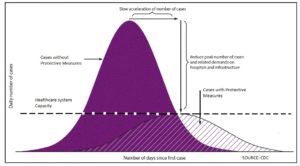Closure of schools and offices has wreaked havoc on families. The cancellation of airline flights, public events, social functions, and the disruption of our economy has been exasperating. We have been thrown into an era dominated by uncertainty, anxiety, and fear.
Are these measures truly necessary to mitigate the current COVID-19 pandemic? The answer is yes. With the lack of a preventive vaccine or definitive treatment for COVID-19, the only way to stop spread is by social distancing and “flattening the curve”. This previously unfamiliar expression is now part of the vernacular. Flattening the curve refers to reducing the number of cases to allow doctors, hospitals and government officials to function at their best without being overwhelmed. It is important to recognize that hospitals have only a finite number of rooms, ventilators and healthcare personnel.
The info-graphic below demonstrates why slowing the spread of the infection is nearly as important as stopping it. While shaped differently, the 2 bell-shaped curves below represent the same number of infected patients. The y-axis or peak of the bell indicates the daily number of cases and the x-axis indicates the time since the first case. The dotted line across the center represents the point at which too many cases in a short period of time will overwhelm the healthcare system.
A large number of people becoming severely ill with COVID-19 over a short period of time as shown in the tall, narrow curve, could result in a shortage of hospital beds, equipment or doctors. On the other hand, as shown in the flatter, longer curve, if the same number of patients presented to the hospital at a slower rate, the likelihood of the hospital to have adequate supplies, beds and health care providers would be higher (Figure 1).

Therefore, in order to mitigate the impact of this pandemic, we need to keep the number of cases to below the dotted line. By doing so, we let our healthcare system function at its best. This also allows time for scientists and researchers to create drugs, therapies and potentially an efficacious vaccine against the virus.
An especially important factor to consider with respect to flattening the curve, is the necessity to keep our healthcare workers–physicians, nurses, and hospital staff–healthy and safe. With an increasing number of cases in the community, the potential for this workforce to get sick is much higher. If healthcare workers become sick, they will need to be excluded from patient care for many weeks. This effect of this is profound, as it will result in less healthcare workers and less qualified individuals available to take care of the sickest COVID-19 patients.
Social distancing may be our only hope to help flatten the curve and slow the spread of disease. Social distancing involves keeping a physical distance between people, at least 6 feet away, to avoid spread of the COVID-19 virus. This decreases the chances of acquisition of the virus and the disease. With the continued acceleration of this pandemic, no measure can be considered too drastic. The horrifying situation in Italy, wherein patients with COVID-19 have inundated the overburdened healthcare system, forcing doctors to make agonizing triage decisions about who should receive lifesaving care, should not be repeated in other countries.
School closures for the purpose of social distancing have especially impacted children and young families. Although current data suggests that children do not appear develop severe illness, it is well-documented that children can still spread the virus to their family members and contacts. Prior influenza pandemics have shown that the highest attack rates were seen in school children due to their close contact. Being separated from friends, can be difficult for children and especially teenagers. Social distancing does not mean social isolation. We can continue to interact using different platforms, such as social media and video applications to help them stay connected during this challenging time.
This is an unprecedented time and although social distancing may be thought to be a dramatic measure, in truth, together as a unified society, we can help slow down the spread of COVID-19. By staying home, you are not just protecting yourself but also other people. It’s the responsible thing to do and although challenging, will help us avoid a situation similar to that of Italy wherein war-like triage decisions and death has become a commonplace.
Comments